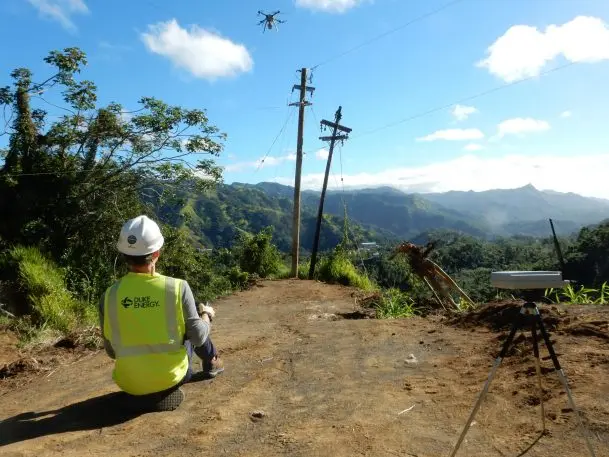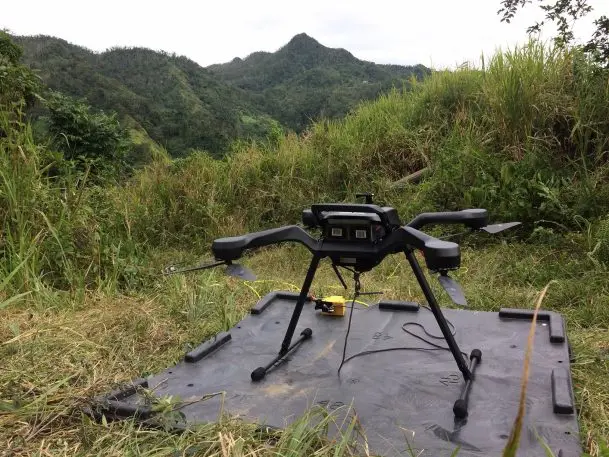In the mountains near Ponce, Puerto Rico, after Hurricane Maria hit, the terrain made it incredibly difficult to repair power lines that used to stretch from peak to peak. For four months, people in the area lived in the dark. In January, Duke Energy started using a new approach to cross 1,000-feet-plus wide ravines: drones.
A drone, carrying a lightweight nylon cord, can quickly fly over dense, jungle-like vegetation to a pole on the opposite side of a ravine. A 3D-printed electromagnet attached to the drone makes it possible to drop the cord in the right position. Next, workers can attach a larger, stronger cord, and then pull the conductor wire into place, making it possible to restore power.
In some other areas, utility companies use helicopters to attach lines; some of the lines in the Puerto Rican mountains were originally installed that way. But helicopters weren’t available to make the repairs, and the work of flying them is also dangerous. After a helicopter pilot suffered a fatal accident in Indiana in 2017, Duke Energy looked for alternatives.

“The question was raised, is there another way to do this?” says Jacob Velky, manager of unmanned aerial systems at Duke Energy. The utility already used drones to inspect solar panels, wind turbines, and transmission lines. But by tweaking the technology, the team realized that it would also be possible to use drones to install distribution lines.
When Duke came to Puerto Rico in January, as part of a group of utilities helping with the recovery, it was the first opportunity to use the drones in regular operation. For six days, assigned to the mountainous area in the south-central part of the island, the team went from location to location flying the drones over hills and valleys. “We were doing upwards of 3-4 pulls in a day,” says Velky. “There was no shortage of work.”
Earlier, workers had attempted an older technique to cross ravines–shooting a brass projectile attached to the same type of nylon cord used by the drones. But the projectile can only travel about 800 feet; several crossings in the area were much longer. The drone strung one cord 1,200 feet, longer than three football fields. Without the drone, it’s also easy to miss the target, and if the cord is lost in the thick vegetation, workers will have to hike out to find it, using machetes to hack a path.

The drones were also used to survey the area, locating broken poles and other infrastructure buried under months of vegetation. “Being in the jungle, once the conductor is off and you just have a wooden pole out in the trees, it’s very difficult to see where the pole is,” he says. “So using the drone to do reconnaissance instead of somebody going out there and walking around trying to find it just minimized the amount of time that our employees are off a road.”
When Duke arrived in January, power had been restored to about 68% of customers in the area they were assigned. A little over a month later–with work that included a week of support from the drones–around 94% of customers have power.
The drones were so efficient that, in some cases, the team put up the cords before conductor wire was available. The island is still struggling to get supplies delivered. The embattled local utility, long criticized for mismanagement (and which will now, controversially, be privatized), is still moving slowly; it may take another month before the majority of residents on the island have power, and perhaps until May before everyone does. In the mountains, without the drones, the process also would have likely continued to be painfully slow. “I think it would have been a much longer time before these places were restored,” says Velky.
Recognize your brand’s excellence by applying to this year’s Brands That Matter Awards before the early-rate deadline, May 3.